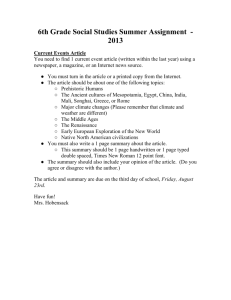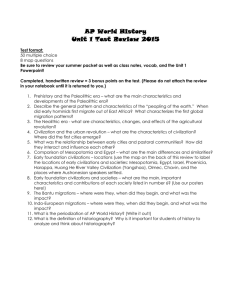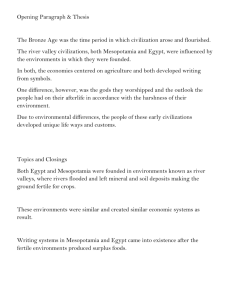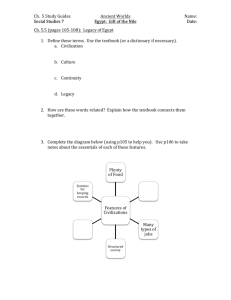File ch 3
advertisement
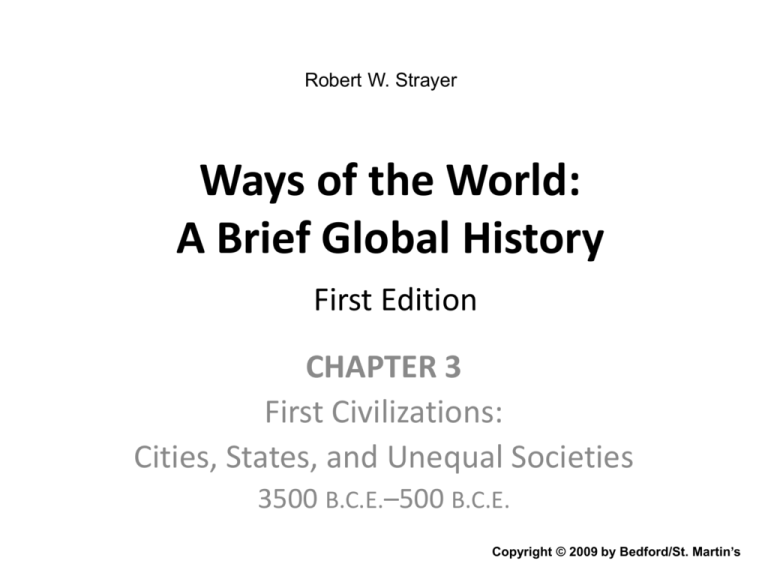
Robert W. Strayer Ways of the World: A Brief Global History First Edition CHAPTER 3 First Civilizations: Cities, States, and Unequal Societies 3500 B.C.E.–500 B.C.E. Copyright © 2009 by Bedford/St. Martin’s Something New: The Emergence of Civilizations Discussion Starter: For you does the term civilization a. conjure up images of superiority? b. suggest refined behavior? c. bring to mind only positive associations? d. bring to mind a mixed or ambivalent set of associations? Introducing the First Civilizations 1. one of the earliest civilizations emerged in Sumer (in southern Mesopotamia) between 3500 and 3000 B.C.E. a. first written language b. appearance of Egyptian civilization in Nile River Valley (northeast Africa) and smaller Nubian civilization to its south at about the same time 2. Norte Chico (central coastal Peru ), emerged between 3000 and 1800 B.C.E. a. twenty-five urban centers b. Norte Chico differed in several ways from Mesopotamia and Egypt c. unusually self-contained; only import was maize, derived from Mesoamerica 3. Indus Valley civilization in Indus and Saraswati river valleys of present-day Pakistan arose between 3000 and 2000 B.C.E. a. elaborately planned cities and standardized weights, measures, architectural styles, and brick sizes b. written script that remains thus far undeciphered c. unlike other civilizations, it generated no palaces, temples, elaborate graves, kings, or warrior classes d. scholars remain uncertain as to how society was organized; theories include a series of small republics, rule by priests, or an early form of the caste system e. environmental degradation led to the collapse of this civilization by about 1700 B.C.E., but several aspects of its culture shaped later Indian societies 4. around 2200 B.C.E., a First Civilization took shape in China a. from the start, China was defined by the ideal of a centralized state b. the Xia, Shang, and Zhou dynasties enlarged the Chinese state c. ruler was the “Son of Heaven,” an intermediary between heaven and earth d. early written language with oracle bones as early documents e. China has maintained impressive cultural continuity into modern times 5. the Olmec produced a First Civilization much later (around 1200 B.C.E.) on coast of Gulf of Mexico, near present-day Veracruz a. cities arose from competing chiefdoms and produced elaborate ceremonial centers b. created the first written language in the Americas by about 900 B.C.E. c. culture influenced later civilizations in Mesoamerica, including the Maya and Teotihuacán 6. other smaller civilizations also flourished a. Nubian civilization south of Egypt was distinctive and independent b. city of Sanxingdui in China arose separately from the more well-known Shang Dynasty The Question of Origins 1. First Civilizations had their roots in the Agricultural Revolution 2. First Civilizations tended to develop from earlier, competing chiefdoms that already had some social rank and economic specialization 3. process was gradual and evolutionary 4. why did some chiefdoms develop into civilizations and others did not? a. one argument: the need to organize large-scale irrigation projects (archeologists have found that these projects appeared long after civilizations began) b. another argument: the needs of elite groups, warfare, and trade all played roles as well c. Robert Carneiro’s argument: population density created competition, especially when agricultural land was limited 5. the creation of the First Civilizations was quick by world history standards but was an unconscious undertaking for those involved 6. all First Civilizations relied on highly productive agriculture An Urban Revolution 1. cities were one of the most distinctive features of First Civilizations 2. the scale, layout, and specialized industries of cities would have impressed visitors from villages 3. cities lay at the heart of all First Civilizations because they were: a. political/administrative capitals b. centers of cultural production—art, architecture, literature, ritual, and ceremony c. places of local and long-distance exchange d. centers of manufacturing activity 4. cities produced new societies with greater specialization and inequality The Erosion of Equality Hierarchies of Class 1. First Civilizations had vast inequalities in wealth, status, and power 2. civilizations multiplied and magnified inequalities that already existed in complex gathering and hunting societies and agricultural chiefdoms 3. these new levels of inequality represent one of the major turning points in the social history of humankind 4. upper classes: a. enjoyed great wealth b. avoided physical labor c. had the finest in everything d. occupied the top positions in political, military, and religious life e. and were frequently distinguished by their clothing, houses, manner of burial, and treatment under the law 5. free commoners formed the vast majority of the population and included artisans of all kinds, lower-level officials, soldiers and police, servants, and farmers a. their surplus production was appropriated to support the upper classes b. some members of these classes recognized and resented their situation 6. slaves were at the bottom of social hierarchies everywhere a. slavery and civilization seem to have emerged together b. first-generation slaves were prisoners of war, criminals, and debtors c. worked in fields, mines, homes, and shops d. more rarely, they were sacrificed e. slavery varied from place to place f. most ancient slavery differed from the more recent American variety Hierarchies of Gender • 1. civilizations everywhere undermined the earlier and more equal relationships between men and women • 2. women in horticultural societies remained relatively equal to men • 3. but patriarchy gradually emerged in First Civilizations • a. more intensive agriculture with animal-drawn plows and large dairy herds favored male labor over female • b. patriarchy also developed in civilizations without plow agriculture, such as Mesoamerica and the Andes • c. David Christian: the declining position of women was a product of growing social complexity d. the association of women with nature because of their role in reproduction may also have played a part • e. warfare may also have contributed to patriarchy • f. private property and commerce also may have played a Comparison: First Civilizations shared all of the following features EXCEPT a. empires of continental size. b. class hierarchies. c. monumental architecture. d. sharp gender inequality. Patriarchy in Practice • • • • • • • • • • • • • 1. Gerda Lerner: emergence of patriarchy in Mesopotamia a. written law codes codified patriarchal family life b. regulation of female sexuality was central c. women in Mesopotamia were sometimes divided into two sharply distinguished categories, depending on protection of one man d. powerful goddesses of Mesopotamia were gradually replaced by male deities 2. Egyptian patriarchy gave women greater opportunities than in most First Civilizations, including ability to: a. own property and slaves b. administer and sell land c. make their own wills d. sign their own marriage contracts e. initiate divorce 3. royal women occasionally wielded political power as regents for their sons or, more rarely, as queens in their own right 4. Egyptian statues and love poetry suggest affection between sexes Discussion Starter: Which of the following is for you the least appealing development that accompanied First Civilizations? a. Slavery b. Patriarchy c. Social stratification d. Wide-scale warfare Mesopotamia Egypt Political: Sumer was organized in a dozen or more separate and independent city-states. Each city was ruled by a king, who claimed to represent the city’s patron deity and who controlled the affairs of the walled city and surrounding rural area. Nevertheless, frequent warfare among these Sumerian city-states caused people living in rural areas to flee to the walled cities for protection. With no overarching authority, rivalry over land and water often led to violent conflict. Political Egyptian civilization, by contrast, began with the merger of several earlier states or chiefdoms into a unified territory that stretched some 1,000 miles along the Nile. Egypt maintained that unity and independence, though with occasional interruptions. Cities in Egypt were far less important than in Mesopotamia, although political capitals, market centers, and major burial sites gave it an urban presence as well. The focus of the Egyptian states resided in the pharaoh, believed to be a god in human form, he alone ensured the daily rising of the sun and the annual flooding of the Nile. All of the country’s many officials served at his pleasure; the law of the land was simply the pharaoh’s edict; the access to the afterlife lay in proximity to him and burial in or near his towering pyramids. Environment: An open environment without serious obstacles to travel made Mesopotamia more vulnerable to invasion than the much more protected space of Egypt. Flooding of the Tigris and Euphrates Rivers helped to provide alluvial soil for productive agriculture. However, flooding of the rivers was unpredictable. Irrigation involved a complex and artificial network of canals and dikes. In Sumer, deforestation and soil erosion decreased crop yields by some 65% between 2400 and 1700 B.C.E. Contributing to this disaster was the increasing salinization of the soil, a long-term outcome of intensive irrigation. As a result, wheat was replaced by barley, which is far more tolerant of salty conditions. Ecological deterioration clearly weakened Sumerian city-states, facilitated their conquest by foreigners, and shifted the center of Mesopotamian civilization permanently to the north. Environment: Egypt was surrounded by deserts, mountains, seas, and cataracts which made it less vulnerable to invasions. Yearly, predictable flooding of the Nile River helped to provide alluvial soil for productive agriculture. Egyptian irrigation was less intrusive by simply regulating the natural flow of the Nile. This avoided the problem of salty soils, allowing agriculture to emphasize wheat production. On occasion their were extended periods of low floods between 2250 and 1950 B.C.E. which led to sharply reduced agricultural output, large-scale starvation, the loss of livestock, and social upheaval and political disruption. Egypt’s ability to work with its more favorable environment enabled a degree of stability and continuity that proved impossible in Sumer. Culture: Mesopotamians viewed humankind as caught in an inherently disorderly world, subject to the whims of capricious and quarreling gods, and facing death without much hope of a life beyond. In the Epic of Gilgamesh, death is described as a journey from which there is no turning back with no hope of light or sustenance. Perhaps it was their environment that gave them this bleak outlook on life and death. Culture: By contrast, elite literate culture in Egypt, produced a rather more cheerful and hopeful outlook on the world, perhaps because of its more predictable, stable, and beneficent environment. The rebirth of the sun every day and of the river every year seemed to assure Egyptians that life would prevail over death. The Rise of the State Coercion and Consent • 1. the state fulfilled a variety of roles in coordinating and regulating the First Civilizations, including: a. organizing irrigation systems • b. adjudicating conflicts • c. defense • 2. the state served the needs of the upper classes by: • a. protecting the privileges of the elites • b. requiring farmers to give up a portion of their product to support city people • c. demanding labor on large public projects • 3. the state frequently used force to secure its will • 4. force was not always necessary because the state often claimed that its authority was normal, natural, and ordained by the gods • a. rule by divine right • b. deference to religion restrained or even undermined the right to rule as in the rule of Chinese emperors by the Mandate of Heaven Writing and Accounting • 1. writing provided support for the state and emerged in all of the First Civilizations except the Andes (though some scholars now regard their knotted strings, or quipus, as a kind of writing) 2. writing sustained the First Civilizations by: • a. defining elite status and conveying prestige on those who wrote • b. allowing some commoners to join the elite through literacy • c. providing a means for propaganda • d. providing a means to keep accurate accounts and complex calendars • e. giving weight to regulations and laws • 3. writing also served functions beyond the state • a. fostered literature, philosophy, astronomy, mathematics, and history • b. sometimes threatened rulers The Grandeur of Kings • • • • 1. source of state authority 2. monumental residences and temples 3. luxurious dress 4. elaborate burials Comparing Mesopotamia and Egypt Environment and Culture • • • • • • • • • • • 1. both depended on rivers, but were very different a. erratic and destructive flooding in Mesopotamia b. Nile flooded more predictably and less destructively 2. Mesopotamia was less geographically isolated than Egypt a. Mesopotamia was vulnerable to external attack b. Egypt was usually protected from external attack 3. many scholars see a relationship between physical setting and culture a. more negative Mesopotamian worldview seems to reflect its precarious and violent environment b. Egyptian worldview reflected the more stable, predictable, and beneficent environment in which it took shape 4. Environmental impact of rising population a. in southern Mesopotamia, deforestation, soil erosion, and salinization of the soil weakened Sumerian city-states, leading to foreign conquest and the northward shift of Mesopotamia’s cultural centers b. Egypt built a more sustainable agricultural system that contributed to the remarkable continuity of its civilization Connection: Which of the following was NOT an outside influence that profoundly shaped the formation of the First Civilization in Egypt? a. Pyramid building from the island of Crete b. Ideas of “divine kingship” from central or eastern Sudan c. Domesticated donkeys and cattle from the Sudan d. The arrival of wheat and barely from Mesopotamia Cities and States • • • • • • • • • • • • • 1. the political systems of Mesopotamia and Egypt differed sharply 2. Mesopotamia for its first thousand years was organized into a dozen or more separate citystates a. each city-state was ruled by a king b. 80 percent of the population lived in city-states for protection c. environmental devastation and endemic warfare ultimately led to conquest by outside forces after about 2350 B.C.E. d. these outside powers built large territorial states or bureaucratic empires encompassing all or most of Mesopotamia 3. Egypt a. around 3100 B.C.E., several earlier states or chiefdoms merged into a unified territory that stretched some 1,000 miles along the Nile b. for 3,000 years, Egypt maintained its unity and independence with few interruptions c. most Egyptians lived in agricultural villages, perhaps because of greater security d. the pharaoh, a god in human form, was the focus of the Egyptian state e. pharaohs were discredited by Nile’s failure to flood around 2200 B.C.E. f. from 2200 to 2000 B.C.E., anarchy; when state was restored, pharaohs never regained their old power Interaction and Exchange • • • • • • • • • • • • • • • • • • • • 1. Egypt and Mesopotamia frequently interacted 2. Egypt ’s agriculture benefited from interaction 3. Mesopotamian models may have influenced Egypt ’s step pyramids and system of writing 4. Egypt ’s “divine kingship” seems to have been derived from central or eastern Sudan 5. both Mesopotamia and Egypt carried on extensive long-distance trade a. Mesopotamian sea trade with the Indus Valley civilization as early as 2300 B.C.E. b. Mesopotamian trade with Anatolia, Egypt , Iran , and Afghanistan c. Egyptian trade in the Mediterranean and Middle East d. Egyptian trade in Nubia and along the East African coast 6. Mesopotamian and Egyptian cultural influences moved along trade routes a. Hebrews migrated from Mesopotamia to Palestine and Egypt early in their history b. Phoenicians (in present-day Lebanon ) were commercially active in the Mediterranean basin c. some Indo-European peoples settled in north-central Anatolia d. sustained contact between Nubia and Egypt e. Egyptian influence can be seen in Minoan art, while Greeks drew heavily upon both Egyptian and Mesopotamian precedents in art, religion, philosophy, and language 7. Mesopotamia and Egypt were also influenced by their neighbors a. Indo-Europeans brought horse-and-chariot-based armies to Mesopotamia; Indo-European Hittites conquered the Babylonian empire in 1595 B.C.E. b. the Hyksos invaded using chariot-based armies and ruled Egypt between 1650 and 1535 B.C.E. c. Mesopotamians and Egyptians adopted chariot technology d. arrival of the Hyksos spurred further innovations in Egypt : new armor and weaponry, new methods of spinning/weaving 8. by 1500 B.C.E., Egypt had become an imperial state a. rule over non-Egyptian peoples in both Africa and Asia b. regular diplomatic correspondence with Middle Eastern empires Change: Which of the following was NOT a development that distinguished First Civilizations from even the most advanced chiefdoms of the Neolithic era? a. States capable of greater oppression of subjects b. Larger populations c. Writing d. Social stratification Chapter 3 First Civilizations: Cities, States, and Unequal Societies, 3500 B.C.E.–500 B.C.E. • • • • • • • • • Map 3.1 First Civilizations (p. 58) Map 3.2 Mesopotamia (p. 75) Map 3.3 An Egyptian Empire (p. 82) Raherka and Mersankh (p. 54) Shang Dynasty Bronze (p. 61) Mohenjo Daro (p. 63) A Mesopotamian Ziggurat (p. 70) Olmec Head (p. 73) Egypt and Nubia (p. 80) Discussion Starter: On the whole, was the emergence of First Civilizations a positive or negative development for humankind? a. The emergence of First Civilizations was a positive development for humankind. b. The emergence of First Civilizations was a negative development for humankind.

